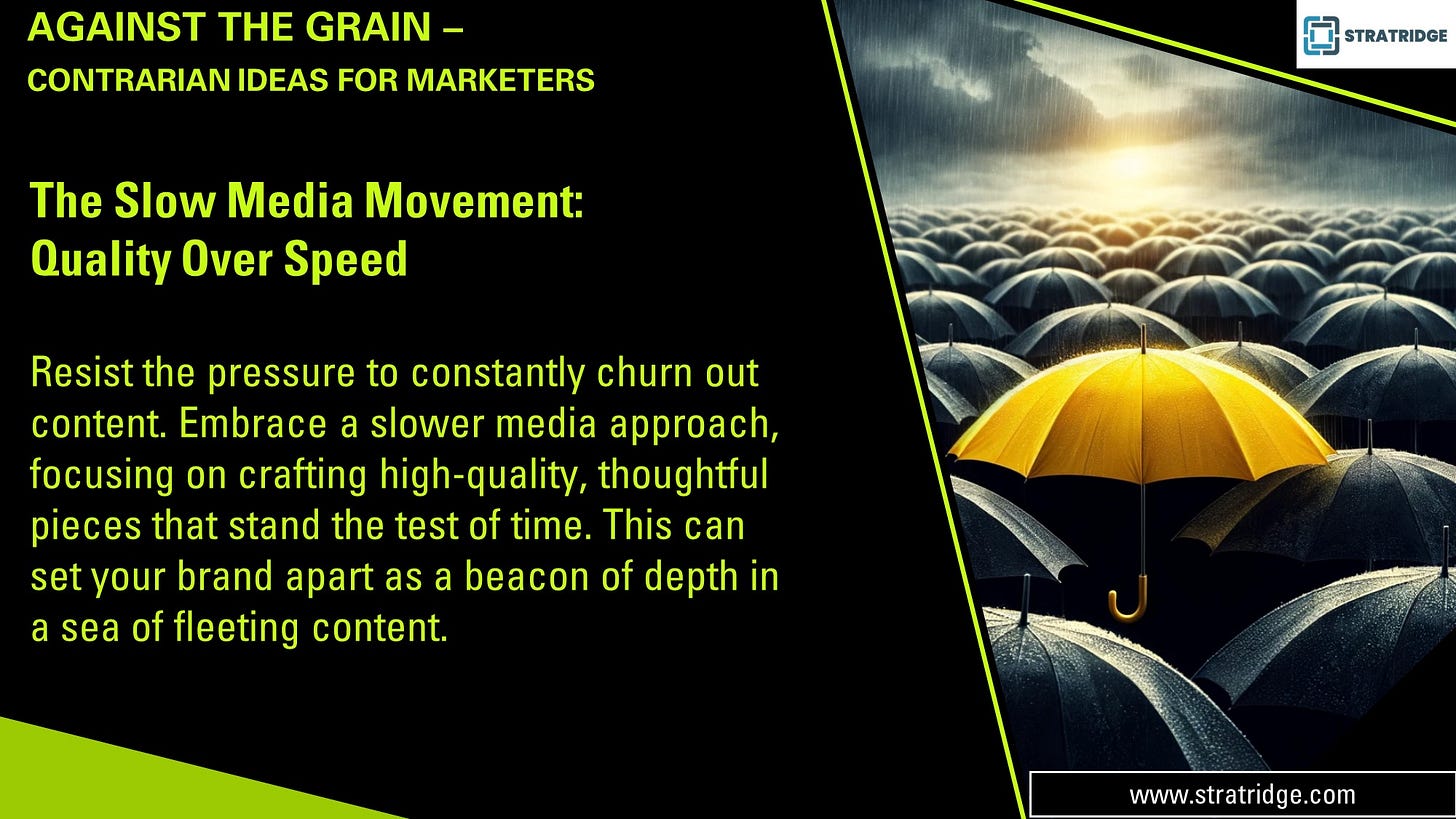The Slow Media Movement: Quality Over Speed
In today's fast-paced digital landscape, where content is consumed at breakneck speed and forgotten just as quickly, a contrarian approach is emerging among forward-thinking marketers: the Slow Media Movement. This philosophy champions quality over speed, emphasizing the creation of content that is not only engaging but also enduring. By resisting the urge to churn out content constantly, brands can differentiate themselves as bastions of depth and thoughtfulness in a sea of fleeting and superficial media.
Understanding the Slow Media Movement
The Slow Media Movement is part of a broader cultural shift towards slowness, which includes slow food, slow living, and slow travel. It advocates for taking the time to create media that offers genuine value, focusing on quality, authenticity, and sustainability over the immediacy and disposability that often characterize digital content. This approach encourages a deeper engagement from audiences, who increasingly crave more meaningful interactions with media and brands.
The Rationale Behind Adopting Slow Media
1. Counteracting Information Overload: In an age of information overload, consumers are bombarded with countless messages daily. Slow media acts as a counterbalance, offering content that requires and rewards more prolonged attention and consideration. This can relieve consumers feeling overwhelmed by the relentless pace of new information.
2. Building Trust and Credibility: High-quality, thoughtfully produced content is more likely to build trust and establish a brand's credibility. When a company invests in creating content that delves deeper into topics, it demonstrates expertise and commitment to value, enhancing its reputation and appeal.
3. Enhancing Audience Engagement and Loyalty: Slow media fosters stronger connections with audiences by providing them a richer, more satisfying experience. Content that remains relevant and provides value can keep consumers returning, deepening their engagement and loyalty to the brand.
Implementing a Slow Media Strategy
1. Prioritize Depth Over Frequency: Instead of pushing out content as frequently as possible, focus on the depth of each piece. Invest more time in research, fact-checking, and crafting narratives that comprehensively view the subject matter. This might mean publishing less often but delivering more impactful content.
2. Embrace Long-Form Content: Long-form articles, videos, and podcasts allow for thoroughly exploring topics and demonstrate a brand's dedication to providing comprehensive insights. They serve as excellent platforms for storytelling, detailed analyses, and expert interviews, all of which can significantly enhance the perceived value of the content.
3. Focus on Evergreen Content: Develop relevant content regardless of the publishing date. Evergreen content can be accessed and shared years after its creation, continuing to drive long-term traffic and engagement. This includes in-depth guides, case studies, and analyses of fundamental issues or techniques within your industry.
4. Leverage Diverse Media Formats: Combine traditional text-based content with other media forms like video, audio, and interactive media to cater to different learning styles and preferences. This diversity not only enriches the content's appeal but also its ability to engage various segments of your audience.
5. Engage with Community and Feedback: Slow media is not just about production but also consumption. Engage with your audience, encourage feedback, and create community discussions around your content. This interaction can provide insights into your audience's values and help refine future content.
Marketing Advantages of Slow Media
1. Stand Out in a Crowded Market: In a digital environment where speed often trumps substance, slow media can help a brand stand out by offering something more thoughtful and substantial. This distinction can attract discerning consumers tired of online content's relentless pace and ephemeral nature.
2. Attract a Niche Audience: Slow media particularly appeals to a niche market of consumers who value depth over speed. These consumers are often more engaged and loyal, providing a solid foundation for building a sustainable customer base.
3. Generate More Meaningful Metrics: While slow media may not initially achieve the viral metrics of more sensational, quickly consumed content, it often generates more meaningful engagement metrics, such as increased time spent on a page, more substantive comments, and higher conversion rates.
As the digital world accelerates, the Slow Media Movement offers a meaningful way to pause and prioritize quality, creating content that resonates deeply with audiences and stands the test of time. By adopting this contrarian approach, marketers set their brands apart and build a loyal audience base that values thoughtful engagement over fleeting consumption. In the long run, embracing the principles of slow media may not just be a niche strategy but a cornerstone of sustainable, impactful marketing.
For more marketing tips, tutorials, templates, and tricks, please subscribe to https://www.stratridge.com


